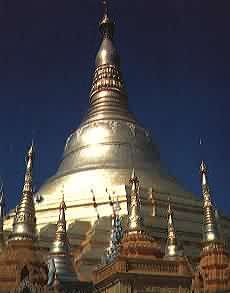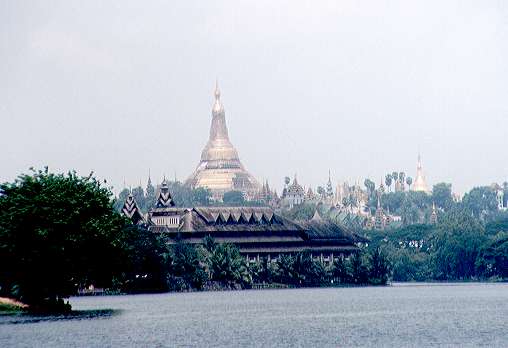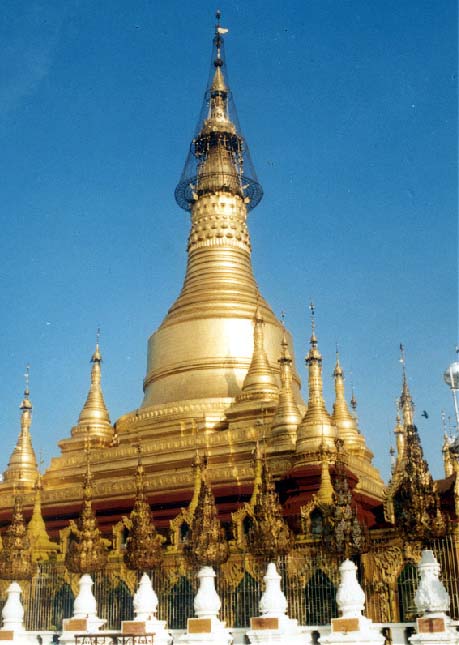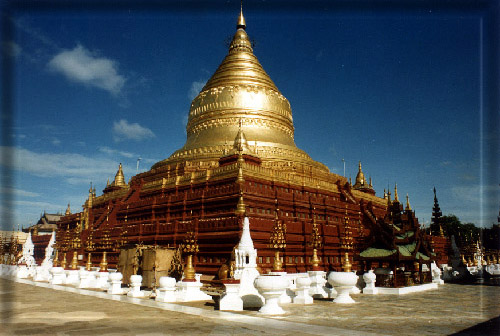SHRINES




( 'Shwe' or 'Shway' means gold/golden)
SHRINES OF BURMA (Myanmar) |
| AUTHORS | SHRINES |
|
| U Ohn Ghine, 1953 | The Botataung Pagoda | |
| U Thaw Kaung, 1998 | Myinkaba, Bagan : Its Legends and Historic Pagodas | |
| Nibbana.com, April 2000 | Shwedagon Pagoda of Burma (Images) | |
| David Maurice, 1952 | The
Shwe Dagon Pagoda |
 |
| Ethel Mannin, 1955 | The Shwe Dagon Pagoda |  |
| U Ohn Ghine, 1953 | The
Shway Sandaw of Prome |
 |
| Sitagu International Buddhist Academy, 1998 | The Shwezigon Pagoda, (Nyaung Oo) |  |
( 'Shwe' or 'Shway' means gold/golden) |
||
| MONUMENT | LOCATION | FIRST BUILT | BUILT BY | REMARKS |
| Abeyadana paya | King Kyansittha | It resembles the Nagayon. Bell-shaped stupa above the terraces | ||
The late inscription attributes it to his chief queen. It is believed to mark the spot where Abeyadana, his wife waited for him. The frescoes represent Bodhisattvas, Brahma, Vishnu, Siva, Indra, etc. |
||||
| Ananda Pahto | Bagan | 1091 or 1105 AD | King Kyansittha | Represents the Endless Wisdom of the Buddha, |
Kyanzittha had probably reproduced the monuments in India of Gupta period. There are life-size statues of King Kyansittha, and Shin Arahan and two Buddha's footprints. The name is believed to originate from Pali word 'Ananta' or Ananda, the Buddha's cousin. There are 4 standing Buddha statues in Mahakaruna Mudra, 31 ft in height; 2 in the North and South are original. |
||||
| Bupaya | Bagan | 3rd Century | The oldest in Bagan ? | |
| Dhammayangyi Pahto | Bagan | 1160-65 | King Narathu | The finest brickwork is to be seen in this temple |
Similar to the Ananda in plan.The king was assassinated by some Indians and it was never completed.; probably named after Ven Dhammaramsi who resided in the vicinity of the Pahto. |
||||
| Dhammayazika | Bagan | 1196 | King Narapatisithu | Pentagonal base with a vaulted shrine on each side |
| The three lower terraces are adorned with Jataka plaques. | ||||
| Gawdawpalin Pahto | Bagan | 1211 | King Narapatisithu | Best sun-set view |
| Htilominlo Pahto | 1 mile to the East of Bagan towards Nyaung Oo | 1211 | King Nantaungmya | Means Tiloka Mangala (in Mon) |
| Kyaik Htiyo Paya | Kyaikto | |||
| Kuthodawa | Mandalay | |||
| Kubyaukkyi temple | Myinkaba | 1113 | Rajakumar | A cave temple |
There was a quadrilingual inscription about his meritorious deed of Rajakumar. It is one of the finest of the early period. |
||||
| Kyauktawgyi Paya | Mandalay | |||
| Lokananda Pagoda | Bagan | 1059 | Tall cylindrical bell, three octagonal terraces | |
| The lower two terraces are ascended by flights of steps on four sides. | ||||
| Mahabodhi Paya | Bagan | 13th Century | After Mahabodhi Temple in India | |
| Mahamuni Paya | Mandalay | |||
| Manuha Paya | Myinkaba | 1059 AD | King Manuha | 31 cetis |
| Mingala Ceti | Bagan | 1268 or 1277 or 1284 | King Narathihapati | |
Beautiful unglazed Jataka plaques round its terraces.On the third terrace there are four larger stupas of conical shape, subsidiary corner stupas and the stairways, and tapering pinnacle abovethe bell. Building work was stopped for 6 years fearing that the country would be destroyed on completion. |
||||
| Myinkaba Pagoda | Bagan | 10th Century before taking Thaton | King Anawrahta | Low round terraces, elongated bell, cylindrical in shape. |
| Said to have been built by Anawrahta in order to expiate the crime of killing his predecessor and half brother, Sokkade, in battle. | ||||
| Nagayon Paya | Bagan | King Kyansittha | The pinnacle, above curvilinear roofs and square terraces. | |
| The outer walls of the shrine and the corridor walls have niches containing stone sculptures depicting the Buddhas anterior to Gautama Buddha. There is a standing stucco image of Buddha of double life-size under the hood of a huge naga (serpent). Legend has it that the temple was built by Kyanzittha on the spot he was given protection by a naga in the course of his flight from Sawlu, his predecessor. | ||||
| Nanpaya | during the reign of Narapatisithu (1173-1210) | A rectangular body | ||
It is believed to be the residence of the captive king Manuha. |
||||
| Patothamya | ||||
| The Patothamya has a and a rectangular vaulted hall. The superstructure consists of three terraces with an ogee roof. In the corridor walls are niches enshrining stone Buddhas. | ||||
| Shwedagon Pagoda | Yangon(Rangoon) | Between 6th-10th Century | The most sacred of all the Buddhist Shrines | |
| Shwegugyi Pahto | Bagan | 1311 AD | King Alaungsithu | Fine stucco carvings/ Pali writings on Stone slabs. |
There are fine stucco carvings. There are Pali inscription on two stone slabs. |
||||
| Shwemawdaw Paya | Pago(Pegu) | Over 1000 years ago | ||
It enshrines some sacred hairs of Buddha obtained from Pago. Also known as Mahapeinne as a stone figure of Ganesh was originally placed at corners of the square terraces. |
||||
| Shwesandaw Paya | Bagan | 1057 | King Anawrahta | Cylindrical bell, five receding terraces |
| Shwethalyaung Paya | Pago(Pegu) | 994 AD | King Migadepa II | Reclinging Buddha |
| Shwezigon Paya | Wetkyi-in | 1084-1113 | King Anawratha, King Kyansittha | Bell on three receding terraces and an octagonal base |
It is the prototype of later Myanmar stupas. Anawrahta commenced the building but completed by Kyansittha. It enshrined sacred relics of the Buddha, collar bone, his frontlet bone and 4 teeth. Kyanzittha erected two large stone pillars inscribed in Mon. Bayinnaung or Hanthawaddy Hsinbyushin who also repaired the pagoda in the 15th century and dedicated a large bronze bell with inscriptions in Pali, Burmese and Mon in 1557 |
||||
| Thatbyinnyu Pahto (Sabbannu) | Bagan, 500 yards from Ananda Paya | 1144 | King Alaungsithu | A height of 201 feet |
It is made up of two enormous cubes, the upper one set back above three intermediate terraces. The huge Buddha image is seated on a masonry throne in the upper cubicle. |
||||
| Upali Thein- Ordination Hall | Wetkyi-in near Htilo-minlo Paya | 13th Century | Named after Venerable Upali during the reigns of King Nantaungmya and King Kya Swa | |
| Myanmar Pilgrimage Photos |
| This page at Nibbana.com was last modified: |